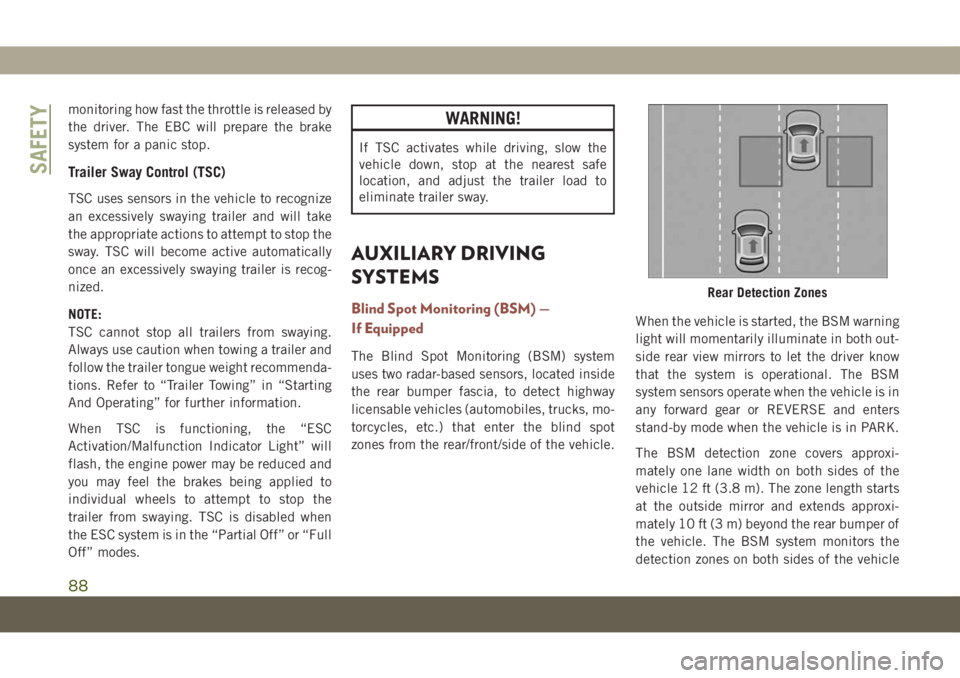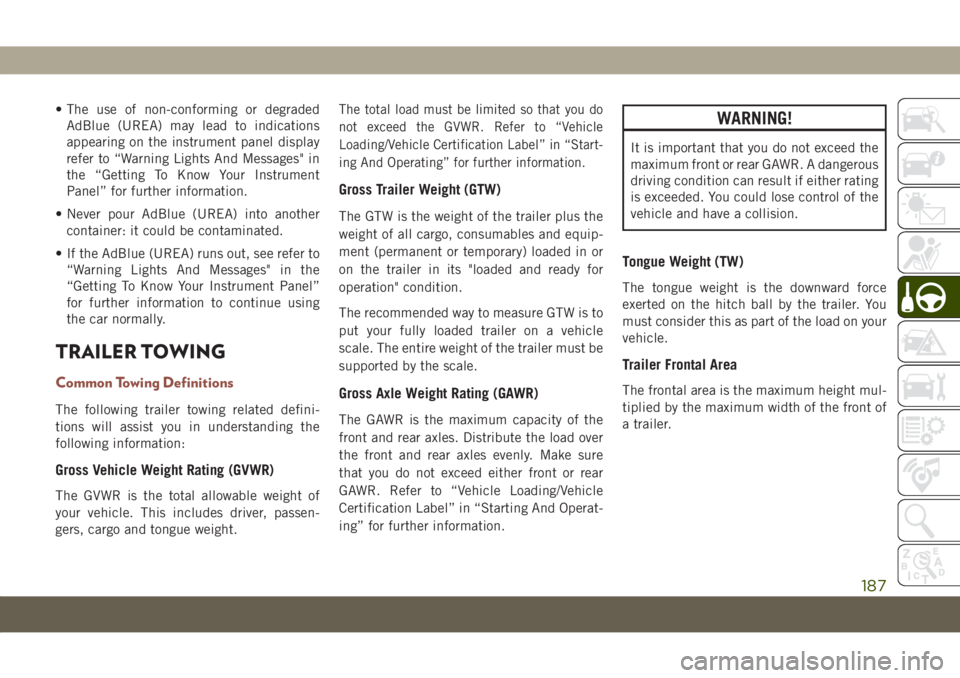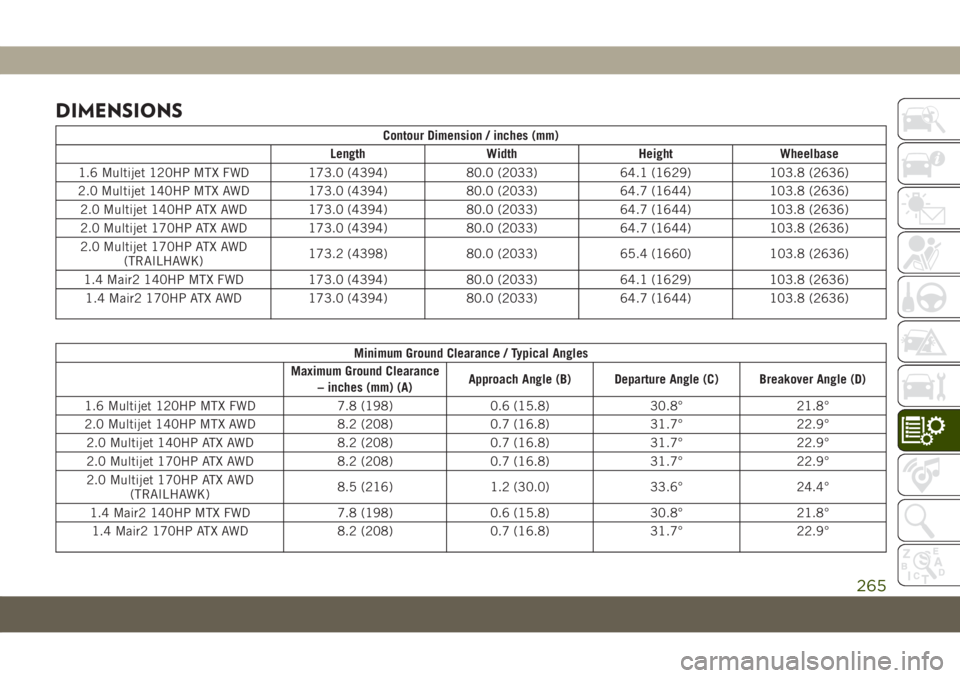width JEEP COMPASS 2019 Owner handbook (in English)
[x] Cancel search | Manufacturer: JEEP, Model Year: 2019, Model line: COMPASS, Model: JEEP COMPASS 2019Pages: 362, PDF Size: 6.23 MB
Page 90 of 362

monitoring how fast the throttle is released by
the driver. The EBC will prepare the brake
system for a panic stop.
Trailer Sway Control (TSC)
TSC uses sensors in the vehicle to recognize
an excessively swaying trailer and will take
the appropriate actions to attempt to stop the
sway. TSC will become active automatically
once an excessively swaying trailer is recog-
nized.
NOTE:
TSC cannot stop all trailers from swaying.
Always use caution when towing a trailer and
follow the trailer tongue weight recommenda-
tions. Refer to “Trailer Towing” in “Starting
And Operating” for further information.
When TSC is functioning, the “ESC
Activation/Malfunction Indicator Light” will
flash, the engine power may be reduced and
you may feel the brakes being applied to
individual wheels to attempt to stop the
trailer from swaying. TSC is disabled when
the ESC system is in the “Partial Off” or “Full
Off” modes.
WARNING!
If TSC activates while driving, slow the
vehicle down, stop at the nearest safe
location, and adjust the trailer load to
eliminate trailer sway.
AUXILIARY DRIVING
SYSTEMS
Blind Spot Monitoring (BSM) —
If Equipped
The Blind Spot Monitoring (BSM) system
uses two radar-based sensors, located inside
the rear bumper fascia, to detect highway
licensable vehicles (automobiles, trucks, mo-
torcycles, etc.) that enter the blind spot
zones from the rear/front/side of the vehicle.When the vehicle is started, the BSM warning
light will momentarily illuminate in both out-
side rear view mirrors to let the driver know
that the system is operational. The BSM
system sensors operate when the vehicle is in
any forward gear or REVERSE and enters
stand-by mode when the vehicle is in PARK.
The BSM detection zone covers approxi-
mately one lane width on both sides of the
vehicle 12 ft (3.8 m). The zone length starts
at the outside mirror and extends approxi-
mately 10 ft (3 m) beyond the rear bumper of
the vehicle. The BSM system monitors the
detection zones on both sides of the vehicle
Rear Detection Zones
SAFETY
88
Page 189 of 362

• The use of non-conforming or degraded
AdBlue (UREA) may lead to indications
appearing on the instrument panel display
refer to “Warning Lights And Messages" in
the “Getting To Know Your Instrument
Panel” for further information.
• Never pour AdBlue (UREA) into another
container: it could be contaminated.
• If the AdBlue (UREA) runs out, see refer to
“Warning Lights And Messages" in the
“Getting To Know Your Instrument Panel”
for further information to continue using
the car normally.
TRAILER TOWING
Common Towing Definitions
The following trailer towing related defini-
tions will assist you in understanding the
following information:
Gross Vehicle Weight Rating (GVWR)
The GVWR is the total allowable weight of
your vehicle. This includes driver, passen-
gers, cargo and tongue weight.
The total load must be limited so that you do
not exceed the GVWR. Refer to “Vehicle
Loading/Vehicle Certification Label” in “Start-
ing And Operating” for further information.
Gross Trailer Weight (GTW)
The GTW is the weight of the trailer plus the
weight of all cargo, consumables and equip-
ment (permanent or temporary) loaded in or
on the trailer in its "loaded and ready for
operation" condition.
The recommended way to measure GTW is to
put your fully loaded trailer on a vehicle
scale. The entire weight of the trailer must be
supported by the scale.
Gross Axle Weight Rating (GAWR)
The GAWR is the maximum capacity of the
front and rear axles. Distribute the load over
the front and rear axles evenly. Make sure
that you do not exceed either front or rear
GAWR. Refer to “Vehicle Loading/Vehicle
Certification Label” in “Starting And Operat-
ing” for further information.
WARNING!
It is important that you do not exceed the
maximum front or rear GAWR. A dangerous
driving condition can result if either rating
is exceeded. You could lose control of the
vehicle and have a collision.
Tongue Weight (TW)
The tongue weight is the downward force
exerted on the hitch ball by the trailer. You
must consider this as part of the load on your
vehicle.
Trailer Frontal Area
The frontal area is the maximum height mul-
tiplied by the maximum width of the front of
a trailer.
187
Page 267 of 362

DIMENSIONS
Contour Dimension / inches (mm)
Length Width Height Wheelbase
1.6 Multijet 120HP MTX FWD 173.0 (4394) 80.0 (2033) 64.1 (1629) 103.8 (2636)
2.0 Multijet 140HP MTX AWD 173.0 (4394) 80.0 (2033) 64.7 (1644) 103.8 (2636)
2.0 Multijet 140HP ATX AWD 173.0 (4394) 80.0 (2033) 64.7 (1644) 103.8 (2636)
2.0 Multijet 170HP ATX AWD 173.0 (4394) 80.0 (2033) 64.7 (1644) 103.8 (2636)
2.0 Multijet 170HP ATX AWD
(TRAILHAWK)173.2 (4398) 80.0 (2033) 65.4 (1660) 103.8 (2636)
1.4 Mair2 140HP MTX FWD 173.0 (4394) 80.0 (2033) 64.1 (1629) 103.8 (2636)
1.4 Mair2 170HP ATX AWD 173.0 (4394) 80.0 (2033) 64.7 (1644) 103.8 (2636)
Minimum Ground Clearance / Typical Angles
Maximum Ground Clearance
– inches (mm) (A)Approach Angle (B) Departure Angle (C) Breakover Angle (D)
1.6 Multijet 120HP MTX FWD 7.8 (198) 0.6 (15.8) 30.8° 21.8°
2.0 Multijet 140HP MTX AWD 8.2 (208) 0.7 (16.8) 31.7° 22.9°
2.0 Multijet 140HP ATX AWD 8.2 (208) 0.7 (16.8) 31.7° 22.9°
2.0 Multijet 170HP ATX AWD 8.2 (208) 0.7 (16.8) 31.7° 22.9°
2.0 Multijet 170HP ATX AWD
(TRAILHAWK)8.5 (216) 1.2 (30.0) 33.6° 24.4°
1.4 Mair2 140HP MTX FWD 7.8 (198) 0.6 (15.8) 30.8° 21.8°
1.4 Mair2 170HP ATX AWD 8.2 (208) 0.7 (16.8) 31.7° 22.9°
265